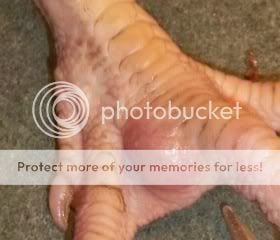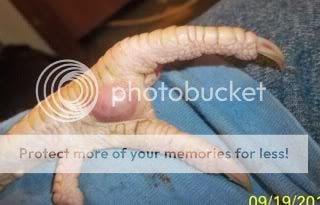Here's a treatment, good for all birds, but mostly chicks and quail due to how much easier they are to hold during the process. I tried it, and it worked miraculously. My Quail's Bumblefoot was reduced in severity overnight.
What you'll need:
-Duramycin-10 Tetracycline Hydrochloride soluble powder. Available at most local feed stores.
-Water
-A large towel
-This requires at least two people.
Step 1. Gather your supplies, mix up the solution, and prepare your workspace. The solution does not have any specific measurements, just mix the soluble powder with the water in a cup, until you have a lump-free paste. Lay down the towel, to prevent spills from reaching the floor during the treatment.
Step 2. Get the affected bird, be sure to clean her feet if necessary, and bring her to the workspace. For birds that do not tolerate handling well, it's better to do this at night, when the bird is calmest. Make sure you have a tight grip on the bird, with feet exposed for the other person's convenience.
Step 3. Smother the affected foot/feet in a generous amount of paste, and set a timer to hold the bird for an extra ten to fifteen minutes to allow the paste to work it's magic. This may sound difficult, but hey, you get to cuddle with your sweet little feathered baby.
 After the time is up, wash the bird's feet and set her back down in her pen.
After the time is up, wash the bird's feet and set her back down in her pen.
Repeat the process again, every night, until the bumblefoot appears to be gone, and then do at least one or two more treatments to ensure that it is completely gone.
What you'll need:
-Duramycin-10 Tetracycline Hydrochloride soluble powder. Available at most local feed stores.
-Water
-A large towel
-This requires at least two people.
Step 1. Gather your supplies, mix up the solution, and prepare your workspace. The solution does not have any specific measurements, just mix the soluble powder with the water in a cup, until you have a lump-free paste. Lay down the towel, to prevent spills from reaching the floor during the treatment.
Step 2. Get the affected bird, be sure to clean her feet if necessary, and bring her to the workspace. For birds that do not tolerate handling well, it's better to do this at night, when the bird is calmest. Make sure you have a tight grip on the bird, with feet exposed for the other person's convenience.
Step 3. Smother the affected foot/feet in a generous amount of paste, and set a timer to hold the bird for an extra ten to fifteen minutes to allow the paste to work it's magic. This may sound difficult, but hey, you get to cuddle with your sweet little feathered baby.

Repeat the process again, every night, until the bumblefoot appears to be gone, and then do at least one or two more treatments to ensure that it is completely gone.
Last edited:




